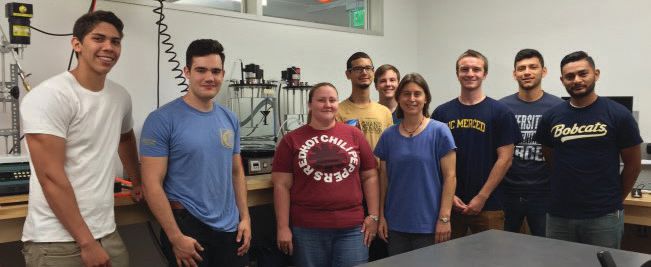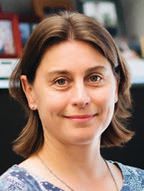Breaking bubbles and barriers
Dr. Ashlie Martini | TLT Industry Relations October 2016
A recent research project on foam control highlights the benefits of industry-collegiate partnerships.

The UC Merced student team that assisted Chevron Lubricants with critical research on controlling foam in lubricants (from left): Edgar Lozano, Nick Walters, Casey Santiago, Matheus Nascimento, Cory Mercer, Dr. Ashlie Martini, Carter Brown, Jorge De Haro Silva and Daniel Garrido Sanchez.
Starting with this issue, TLT will highlight collaborations between a company and a university where the two groups work together to solve important problems in tribology and lubrication engineering. Our hope is that these columns will highlight what is rapidly emerging as an important industry trend—how partnerships between STLE members in industry and academia can significantly benefit both sides and enable research teams to solve problems that neither could have tackled alone. (If you have ideas for industry-university collaborations that you think demonstrate this theme, please contact Ashlie Martini at amartini@ucmerced.edu, and your collaboration could be highlighted in an upcoming issue of TLT.)
FOAM CAN BE VERY BAD FOR LUBRICATION because it prevents the lubricant from performing its basic function of separating two solid surfaces. Foam is controlled in lubricants with additives called foam inhibitors, and most commercial foam inhibitors are very effective at quickly breaking down foam bubbles after they form on the surface of the fluid. However, it has been found that some foam inhibitors, particularly those composed of silicone-based droplets, can be detected by optical particle counters as contaminants. This presents a problem for companies in the lubricant and additive business because customers might perceive new oil to be dirty when in fact it just contains helpful foam-controlling additives.
This is the challenge that Chevron Lubricants faced when it teamed with the University of California, Merced (UC Merced), to find creative ways to tackle the foam problem. The collaboration turned out to be a perfect match between the chemists at Chevron, who have experience with and detailed knowledge of the additives and their function, and the mechanical engineering students at UC Merced, where I served as their mentor. The goal of the project was to characterize how foam performance and optically detected oil cleanliness are affected by filtration. To approach this challenge, Chevron needed a way to measure both foam performance and cleanliness as well as the manpower to perform a huge number of tests with different additives and filter parameters. The UC Merced team turned out to be the perfect solution.
Students at UC Merced designed and built a test rig to enable filtration and particle counting and used it, along with a standard foam measurement setup, to perform tests. The team successfully identified combinations of additive treat rate, filter pore size and number of passes through the filter that optimized both additive-induced particle counts and foam performance.
This information is extremely valuable to Chevron where it can be used to inform decisions about lubricant formulations. At the same time, being involved in this project gives the UC Merced students valuable experience working on a real-world problem alongside practicing scientists and engineers. So far one master’s student and 12 undergraduate students have participated in the project, all of whom now know about the exciting field of tribology and lubrication engineering.
The project was initiated by a simple conversation at the STLE Northern California Local Section meeting between me and former Chevron employee Dr. Jack Zakarian. Both parties saw the potential benefit of the collaboration for their organizations. Scott Deskin, driveline scientist for Chevron Lubricants, says, “Chevron needs high-quality laboratory studies to supplement our in-house R&D activities. By partnering with UC Merced, we fill this resource gap and get answers to fundamental questions that will aid us in developing new products. Just as important, the students gain practical experience in a laboratory setting and learn how to apply their classroom knowledge to solve real-world problems.”
This collaboration, like others you will read about in upcoming articles, provides critical resources to companies, offers valuable industrially relevant experience to students as they prepare for their careers and (we hope) lays the groundwork for the next generation of scientists and engineers in our field.
 Ashlie Martini is a professor at the University of California-Merced and a member of STLE’s board of directors. You can reach her at amartini@ucmerced.edu
Ashlie Martini is a professor at the University of California-Merced and a member of STLE’s board of directors. You can reach her at amartini@ucmerced.edu.